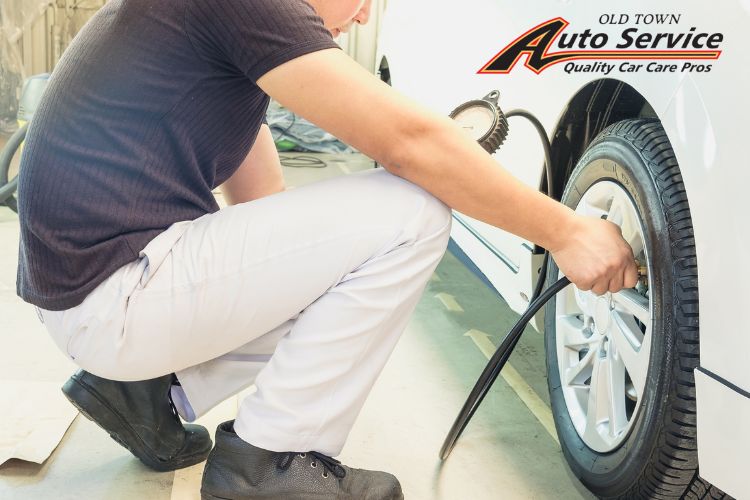Your vehicle's tires are the only point of contact between your car and the road, making them a critical component for safety, efficiency, and overall performance. One essential feature that helps maintain proper tire care is the Tire Pressure Monitoring System (TPMS). But what exactly is TPMS, how does it work, and when should you seek professional service? Let’s break it down so you can stay safe and keep your tires in top shape.
What is a Tire Pressure Monitoring System (TPMS)?
TPMS is a safety feature designed to alert drivers when their tire pressure is too low or too high. Since proper tire pressure is crucial for optimal handling, fuel efficiency, and tire longevity, TPMS helps prevent issues like tire blowouts, poor traction, and unnecessary fuel consumption.
There are two types of TPMS systems:
- Direct TPMS: Uses pressure sensors inside each tire to measure air pressure and transmit real-time data to your vehicle’s onboard computer.
- Indirect TPMS: Monitors tire pressure by using wheel speed sensors from the anti-lock braking system (ABS) to detect changes in tire rotation speed, which can indicate underinflation.
When tire pressure falls below the recommended level, the TPMS warning light (a horseshoe-shaped symbol with an exclamation point) will illuminate on your dashboard, signaling the need to check and adjust your tire pressure.
How Does TPMS Work?
In direct TPMS, each tire has a sensor that sends information to your vehicle’s control module. If the pressure drops below the manufacturer’s recommended level, the system activates a warning light. These sensors are battery-powered and can last anywhere from 5 to 10 years, depending on driving conditions and usage.
In indirect TPMS, the system uses ABS wheel speed sensors to detect variations in rotation speed. A low-pressure tire will rotate at a different rate compared to properly inflated tires, triggering the warning light if a significant difference is detected.
Regardless of the system type, when the TPMS warning light turns on, it’s important to check your tire pressure and inflate your tires to the correct PSI as listed in your owner’s manual or the driver’s side door sticker.
When Does Your TPMS Need Service?
While TPMS is designed to help you monitor tire pressure, like any other vehicle system, it can experience issues that require service. Here are some common situations when TPMS may need attention:
1. Persistent TPMS Warning Light
If the TPMS light remains on after inflating your tires to the correct pressure, there may be a problem with a sensor, or the system may need recalibration. A flashing TPMS light could also indicate a sensor failure.
2. Dead or Weak Sensor Batteries
Since direct TPMS sensors are battery-powered, they eventually wear out. If your vehicle is older or has high mileage, you may need to replace the TPMS sensors.
3. TPMS Sensor Damage
Sensors can be damaged during tire changes, pothole impacts, or exposure to extreme weather conditions. If you suspect sensor damage, professional diagnostics can pinpoint the issue.
4. Incorrect Sensor Programming
If you’ve recently replaced a TPMS sensor, it may need to be reprogrammed to communicate with your vehicle’s computer. This is especially common when installing aftermarket wheels or tires.
5. Faulty Indirect TPMS Readings
For vehicles with indirect TPMS, certain conditions—like uneven tire wear or recent tire rotations—can cause inaccurate readings. The system may need recalibration to function properly.
When to Take Your Vehicle to the Pros at Old Town Auto Service
While you can manually check and inflate your tires, TPMS repairs and diagnostics are best handled by professionals. If you experience any of the issues mentioned above, bring your vehicle to Old Town Auto Service for expert inspection and repair.
At Old Town Auto Service, we provide:
- Comprehensive TPMS diagnostics to determine sensor or system malfunctions.
- Sensor replacement and reprogramming for direct TPMS systems.
- Tire pressure adjustments and recalibration for both direct and indirect TPMS.
- Routine maintenance checks to ensure TPMS functions properly and enhances your driving safety.
Ignoring TPMS warnings can lead to decreased fuel efficiency, increased tire wear, and potential blowouts, putting you and your passengers at risk. Let our experienced technicians diagnose and resolve your TPMS concerns so you can drive with confidence.
Final Thoughts
Your Tire Pressure Monitoring System (TPMS) is an essential safety feature that ensures your tires maintain proper inflation levels. Understanding how TPMS works and recognizing when it needs service can save you from costly repairs and unsafe driving conditions.
If your TPMS warning light is on, or if you suspect sensor issues, visit Old Town Auto Service today for professional assistance. Our team is here to keep your tires—and your vehicle—running smoothly, safely, and efficiently!

